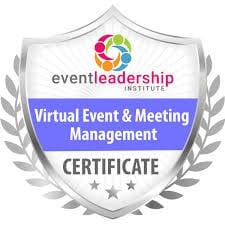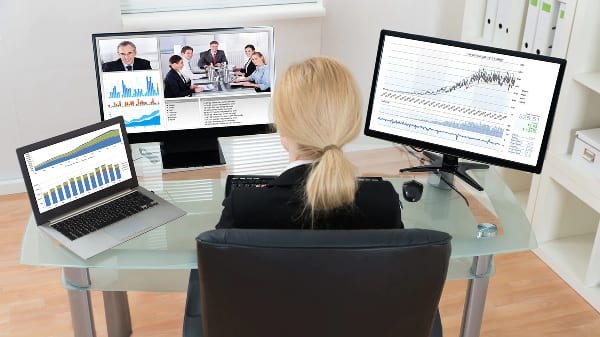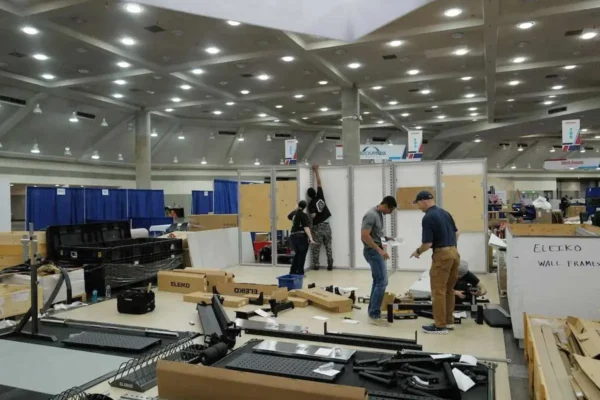by Candy Adams, “The Booth Mom®”, VEMM | CTSM | CME | CEM | CMP | CMM
 Since COVID-19 reared its ugly head in February, all my clients’ tradeshows have either postponed, canceled or gone virtual. But, like any exhibit pro worth their salt, I’ve been working on Plan B (see my last ECN article at exhibitcitynews.com/plan-b-whats-next-with-tradeshows-and-events). Since March I’ve become a professional student of virtual events from all perspectives—the show manager, the technology platforms, the attendee experience and the exhibitor/sponsor. There’s a lot out there to absorb, but I’ve learned a dozen new lessons in morphing from an exhibitor at live events to virtual ones. Thinking through this evolution before taking the leap into virtual events can save you time, money and hassles as you make the transition—hopefully temporarily—until we can move forward to hybrid (live + virtual) exhibits.
Since COVID-19 reared its ugly head in February, all my clients’ tradeshows have either postponed, canceled or gone virtual. But, like any exhibit pro worth their salt, I’ve been working on Plan B (see my last ECN article at exhibitcitynews.com/plan-b-whats-next-with-tradeshows-and-events). Since March I’ve become a professional student of virtual events from all perspectives—the show manager, the technology platforms, the attendee experience and the exhibitor/sponsor. There’s a lot out there to absorb, but I’ve learned a dozen new lessons in morphing from an exhibitor at live events to virtual ones. Thinking through this evolution before taking the leap into virtual events can save you time, money and hassles as you make the transition—hopefully temporarily—until we can move forward to hybrid (live + virtual) exhibits.
1 Go back to the “Why?” of exhibiting.
With our current moratorium on holding mass gatherings that’s forcing us to exhibit virtually, it’s a great time to start over with a clean slate to rethink exactly what we want to accomplish strategically as exhibitors. How can we best show our products/services, educate our prospects, showcase our brand and build awareness using the virtual exhibiting platform provided by show management? One advantage of virtual events is having the ability to collect additional attendee data online based on their interests and their online conference activities.
2 Don’t cut the budget…yet!
Although your live exhibit budget contained costs you know you won’t have exhibiting virtually like staff travel, exhibit design/build/shipping, material handling, utilities and I&D, don’t be too hasty to relinquish these funds. With the sudden influx of virtual event business after the pandemic, platform providers have multiplied like rabbits. Based on the law of supply and demand, pricing spiked. Exhibitors aren’t used to budgeting for this level of technology—the increasing cost for all the production, computer resources and AV required, not to mention the technical staffing to run them. Until you’ve nailed down your virtual exhibit’s details—your goals, the scope of your virtual exhibit, your level of participation and sponsorship costs, and decided how you’ll need to up your game to engage your prospects through ancillary marketing—hold on to every penny of your budget that you can.
3 Identify and poll your (new) stakeholders.
There may be new corporate stakeholders who’ll want to be involved in your transition to virtual events. Who—both internally and externally—will have input to share on their goals and objectives for your virtual exhibit? Other than your company’s internal marketing and sales management teams, who else should you solicit input from? For example, if you work with outside social media or experiential agencies, or promotional products specialists, bring them into the loop to get their feedback. Compile all stakeholder input and then share it with show management.The more they understand your overall goals and objectives, the closer they can align their exhibiting and sponsorship opportunities to your virtual exhibiting needs.
4 What data will be available to exhibitors?
The difference between information and data is that you’ll actually use data for future decision-making. Find out from show management what data they’ll provide, when you’ll receive it and in what format. Will it be shared as summarized totals, or will there be personally identifiable information (a.k.a. PII) that can be used for follow-up? Based on your goals and objectives, how will this information/data help you to prove your return (whether return-on-investment, return-on-objective, return-on-relationship or return-on-experience)?
5 How will you measure success?
What results will give your virtual event a thumbs up? How will this change your measurement criteria from how you used to measure success at your live events? Will you attempt to compare your results from live vs. virtual show participation? Will you use it to improve your next virtual event?
 6 Know how long your virtual presence will last.
6 Know how long your virtual presence will last.
One of my client’s tradeshows transitioned from three days live onsite to one six-hour/single-day of exhibiting, plus six months online. Understanding how long you can realistically milk your virtual show presence with a combination of show-connected marketing opportunities tied in with your other on-demand marketing content can increase your branding and awareness exponentially. And hopefully it will expose you to a much larger potential audience.
7 What sponsorship options are available?
Although show managers are experts at offering boring packaged stone (diamond/ruby/emerald) or metal (platinum/gold/silver) sponsorships, I’ve rarely seen a show manager who wouldn’t entertain ideas and offers to build your own custom sponsorship. Will you have access to the event’s full attendee list? To distribute a branded giveaway to either a physical or virtual SWAG bag? Create additional touchpoints like speakership slots, between session video clips, mentions by the moderator/host, presenting or sponsoring a breakout or networking session, hosting an entertainment—or health-related break—or gamification opportunities for prizes?
8 Know your options for “building” your virtual exhibit.
Contractually, are you bound to the show manager’s platform’s limited exhibit options? The “vanilla” ones only have an exhibitor profile listing with a generic 2D rendered exhibit that allow adding a logo and graphics, literature, a video and possibly access to a chat room. Or are you allowed to upload or link to your own custom, multi-dimensional (3D) exhibit with virtual walkthroughs, video conferencing with your sales reps, customized live demos and pre-set meetings? Just like show managers have controlled live exhibitors’ abilities to customize their show presence with their standardized rules and regulations, they are reluctant to relinquish control to exhibitors who want to go the extra mile to stand out for fear of making their vanilla ones look shabby.
9 Remember, your marketing options still extend beyond your virtual “booth” space.
Don’t let show management dictate what your overall brand’s marketing campaign will look like beyond whatever virtual exhibit package you are purchasing. Consider mailing your best customers and prospects a custom SWAG box containing their selection of beer, wine, liquor or mocktail ingredients and “paired” snacks for a company-sponsored Zoom happy hour held the evening before show opening. Or consider a food-delivery e-gift card for lunch the day of the show. You can also generate excitement (and even some social media buzz) using gamification like scavenger hunts or trivia quizzes for valuable prizes or bragging rights.
10 Plan your integrated pre-show promotion, at-show engagement and post-show follow-up with your booth visitors.
Consider offering your best customer/evangelists/influencers “scholarships” to attend the virtual event and post to social media about your offerings. Other opportunities to reach out to your customers can include speakerships on a panel in a break-out room that your company is sponsoring, gamification with leaderboards announcing winners on social media, sponsored entertainment breaks, etc. Use all three opportunities to reach out.
11 Myth: Just because your exhibit’s “virtual,” you don’t need both planning and virtual onsite staff.
For an average virtual exhibit, you’ll still need to design it, and create and upload your profile, demos, videos and .pdfs of your sales literature. And based on your anticipated level of attendee traffic, you will still need to staff—and, more importantly, train those staffers on the skills to best engage visitors virtually—to work in your exhibit during show hours. Who will greet your guests in your exhibit chat room, and what contact information will they gather via virtual badge scanning, and how? How will this contact information be passed on to a sales representative, who will qualify them to find out their needs and give them a virtual exhibit tour? Will the same staff person share the self-guided demo you’ve uploaded, or can they move to a private chat room for a custom demo? Or can a one-on-one virtual meeting with a product specialist be easily scheduled online at a better time outside of the virtual show hours? And just like a live event, somebody has to get all these leads into the company’s CRM system for further analysis and follow-up.
12 Determine who will manage your ongoing presence on the show’s virtual website.
After virtual show hours, what will your visitors’ access to your on-demand virtual exhibit on the show’s website look like? Will they be able to access your staff to chat or schedule a video call for a demo, even if they are in a global—and vastly different—time zone? And once you’re back on the “show circuit” with multiple virtual exhibits online concurrently, how will you manage the traffic and inbound requests for information from multiple virtual shows? Is it possible to redirect your individual show presence to a landing page on your own company’s website, and build a more engaging, experiential exhibit there, for everyone to access that funnels all inquiries to a centralized staff?
Don’t give up on virtual exhibits too easily. There is potential there (although it sure isn’t equivalent to the excitement on our live show floors!). As our industry evolves through the pandemic, platforms allow more engagement, and show managers learn that what they’re currently offering us doesn’t help us engage with our target audience, expect to see improvements in how we can still reach our virtual booth visitors.
 Candy Adams, known throughout the exhibit industry as “The Booth Mom,®” is a hands-on exhibit project manager who’s earned six industry certifications and has more than 495 shows under her belt. As an accomplished veteran exhibit marketing consultant and exhibit staff “boothmanship” and exhibit management trainer, she specializes in sharing her knowledge and experience to guide exhibitors through the tradeshow maze, assuring they maximize their return on investment while cutting exhibiting costs. A prolific, award-winning writer and trainer on exhibiting best practices, she’s published more than 400 articles and blogs and trained tens of thousands of exhibit managers on all aspects of tradeshow exhibit management in her 29-year career. For more info, visit www.BoothMom.com.
Candy Adams, known throughout the exhibit industry as “The Booth Mom,®” is a hands-on exhibit project manager who’s earned six industry certifications and has more than 495 shows under her belt. As an accomplished veteran exhibit marketing consultant and exhibit staff “boothmanship” and exhibit management trainer, she specializes in sharing her knowledge and experience to guide exhibitors through the tradeshow maze, assuring they maximize their return on investment while cutting exhibiting costs. A prolific, award-winning writer and trainer on exhibiting best practices, she’s published more than 400 articles and blogs and trained tens of thousands of exhibit managers on all aspects of tradeshow exhibit management in her 29-year career. For more info, visit www.BoothMom.com.


This story originally appeared in the Nov./Dec. 2020 issue of Exhibit City News, p. 26-28. For original layout, visit https://issuu.com/exhibitcitynews/docs/ecn_nov-dec_2020






























